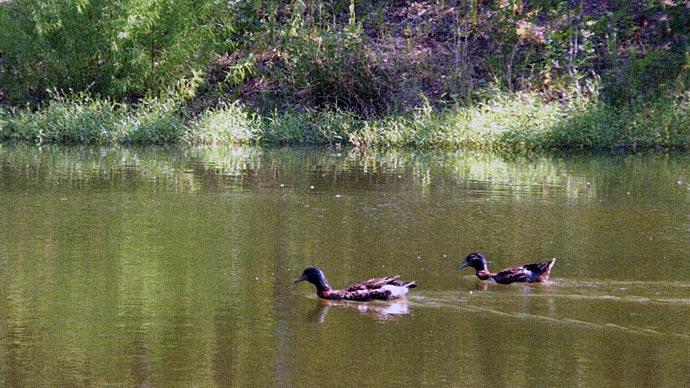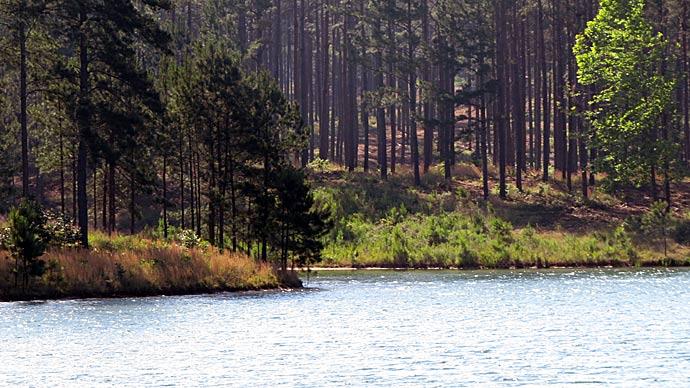
The 6300 acre Florida wildlife refuge named for Pulitzer prize-winning cartoonist and pioneer environmentalist Jay Norwood Darling is, at last count, home to 238 species of birds, more than 50 reptiles, and 32 kinds of mammals. The size and complexity of this "major league" refuge on the barrier island of Sanibel in the Gulf of Mexico, is a fitting memorial to the visionary conservationist.
Lake Darling, nestled in farmland of Iowa, is another namesake of Darling, who passed away in 1962. This state park and its 305 acre lake built in 1950, near Brighton in southeast Iowa, may not have the same "major league" credentials as the Florida wildlife refuge, but it has been a place for swimmers, campers, boaters, and anglers, along with nature enthusiasts to spend much time over the years.
By the late 1990s the lake had shrunk to 287 acres. Sediment washing from surrounding watershed was filling the lake. Excess nutrients, pesticides and bacteria were washing in with sediment. Water became cloudy, fish habitat declined, and fecal contamination led to swimming advisories at the beach. It looked like a "major league" effort was needed to get the lake back in the "ball game."
The Iowa Department of Natural Resources identified fecal contamination (indicated by high E. coli bacteria levels) was a problem in the lake. While siltation wasn't the primary problem, it was the vehicle. "Shortstopping siltation" ended up going a long way to repairing the lake.
With the problem identified, the Washington County, Iowa Soil and Water Conservation District commissioners and the National Resources Conservation Service devised a plan. The plan was to build terraces, ponds and water management structures to slow the flow of water with more water storage area.
And while the team would have some great Success at the "bi-lake level." it also would provide some "minor league" entertainment for some. Increased pond acreage in the watershed area with improved conservation practices for the land added recreational resources for landowners. More ponds.
One interesting statistic shows total combined pond surface areas created by the project at 91.1 acres. Drainage areas treated with terraces and basins totaled 1,346 acres. This area, added to existing pond drainage, equals 4,978 acres controlled to help solve siltation.
Stan Simmons, with 36 years in the Natural Resources Conservation Service, was brought out of retirement to serve as part time consultant for Pathfinders RC&D. He was watershed coordinator or "general manager" for the project. "Lake Darling is a tremendous public resource and worth saving and protecting," Simmons said in review of the happenings of the 5 year reclamation period. "Without partnerships with various groups and landowners, you can't do what needs to be done,"
In the case of the rebirth of the lake, this was certainly the case. "You may have heard the term, 'it takes a village.' In Lake Darling's case, it took a watershed," Simmons said.

For Lake Darling, water clarity decreased in the mid-1970s as intensive agriculture tillage practices allowed sediment to deposit into the lake. "It was always darker colored then," said Don Kline, DNR fisheries biologist who has worked at the Lake for 35 years. "In the spring, the lake was the same color as hot chocolate." Kline's monthly water clarity testing since 1978 has shown the effect of sediment washing into the lake.
Conservation practices had been part of the Lake Darling watershed for years. Tile outlet terrace systems and water control basins were used in the watershed on a smaller scale since the 1960s. The new plan was more of the same. It worked.
Since all types of material attaches to soil washed toward the lake, slow release of runoff allows sediment to settle out before reaching a stream. Tile outlet terrace systems are designed to store water until the tile can take it away.
The cleaner lake is the result of hard work and partnership of many landowners, groups, and agencies. Land owner cooperation was important.
"The key people were the farmers," explained project director Simmons. "Many had to think on a collective watershed basis rather than a farm basis, and they had to be convinced that there needed to be a partnership approach to the problem."
A good example of a farmer who needed to be convinced was Donnie B. Dickinson, a Washington County farmer whose land is close to the lake. He has farmed in the watershed all his life. Selling him on no-till practices wasn't easy. "At first I wasn't very enthused about it. It was a big change for me. It seemed like a sloppy way of farming," Dickinson explained. Today he recognizes the benefits of different cropping practices. He has water conservation practices scattered throughout his farmland--tile outlet terraces, more than 10 ponds, and nutrient management. "It seems like the right thing to do. I figure it's the best for soil conservation, that's a big plus," he said. "Plus you save wear and tear on your machinery. Fewer trips in the field save fuel, and there's less erosion."
Dickinson also fishes in Lake Darling from time to time, and has noticed a change in the water.
Craig Wright, another member of the "farm team," works about 400 acres in the Lake Darling watershed and has installed a number of practices, including three ponds. "It means soil is staying where it's supposed to be," Wright said. One of his ponds is the largest installed by the lake Darling Watershed project. "Before, it was just a big ditch, not farmable ground," Wright continued. "However, funding from the project made the pond possible. It would have been hard for me to afford to do it without help." In addition to the lake's benefits, Wright is seeing cost savings from nutrient management and total no-till practices.
129 construction projects have been completed, involving 56 of 71 landowners in the watershed, and that's a heck of a batting average. Many were group projects, collaborations between the watershed project, multiple landowners and other agencies and organizations. The 12,500 acre drainage area into the lake consists of land in three counties, so the cooperation across county lines and agencies was a real plus. Also, of the 129 projects, 59 involved two or more landowners. This makes 46 percent of the projects that were involved in group effort and cooperation. The total cost of the 129 projects was $1,283,461 dollars, of which $919,046 dollars in cost share funding was spent. Of the 129 projects, 28 were erosion control ponds. The remainder were tile outlet terraces and tile outlet sediment and water control basins.
A detailed analysis of the drainage area indicates 72% of runoff from private lands either flows into tile outlet terraces and basins or erosion control ponds. Each of these permanent practices traps 95% of the sediment from the area flowing to the lake. Of the remaining 28% of private lands, some is non-highly erodable, some is in CRP, and some is grass and woodland. This means a large percentage of the highly erodible land in the watershed is controlled.
Without conservation practices, more than 16,000 tons of sediment were reaching Lake Darling every year. Initial conservation practices reduced that number to 10,444 tons per year by 1999. The watershed project over the last 6 years has brought the figure to 6,978 tons per year. And as used in the game of baseball, that is "pitching" a great "Earned Run Average."
In 2005, only three swimming advisories were posted, half the number of a year before, a significant decrease from 11 in 2002. As water quality has improved, camping and park usage rebounded.
Fish especially benefit from improved water quality at Lake Darling. And that's good news for anglers who come to Lake Darling for a shot at bass, bluegill, crappie, and catfish. With better water quality, the lake is seeing blooms of beneficial plankton. As fisheries biologist, Don Kline says, "It's fired up the food chain.
What does this success story mean to you, dear pondmeister? Pay attention to siltation. When a pond is built, it's often not enough. Pay attention to the entire watershed. The watershed influences your lake, your pond and its life.
Reprinted with permission from Pond Boss Magazine



